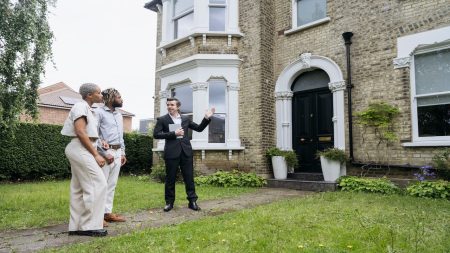Thomas Barwick/Getty Images
Key takeaways
- A convertible ARM includes a clause that lets borrowers switch from an adjustable interest rate to a fixed one, usually for a fee.
- A convertible mortgage allows borrowers to take advantage of the lower interest rates that come with adjustable-rate mortgages and still maintain the option for predictable payments later.
- If you want to benefit from a lower introductory rate to afford a home faster, a convertible ARM loan could be right for you.
A convertible adjustable-rate mortgage (ARM) can be an appealing option for first-time homebuyers looking for lower initial interest rates and monthly payments. It comes with some risk, though, so it’s not the right choice for everyone. Here’s what you need to know about a convertible ARM and how it works.
What is a convertible ARM?
A convertible adjustable-rate mortgage allows the borrower to change from an adjustable rate to a fixed one after the initial fixed-rate period expires without refinancing. You might also hear this option called a conversion clause or part of a conversion-option mortgage.
If you choose to convert your mortgage when the introductory rate period ends, usually after five, seven or 10 years into the loan term, you typically have to pay a small fee to use this option. That said, you can benefit from receiving a set interest rate for the loan’s remaining duration, which means more stable, predictable monthly payments.
How do convertible ARMs work?
To understand a convertible ARM loan, it helps to understand how it starts: as a hybrid ARM loan.
A hybrid ARM loan gets its name because it consists of two parts:
- The fixed-rate period: Your loan begins with a fixed rate for a set period of time (e.g., five years). In this phase, the payments stay the same each month. Many borrowers appreciate this stability in their monthly budget, especially as interest rates tend to trend upward.
- The adjustable-rate period: After the fixed-rate period ends, the loan adjusts to a variable-rate mortgage. From there, the interest rate goes up or down at predetermined times (for example, every six months or once a year) based on prevailing market rates. These fluctuating interest rates will either raise or lower your monthly mortgage payment. The rate is based on an index, such as the Secured Overnight Financing Rate (SOFR), and whatever margin is stated in the loan documents.
If you have a conversion-option mortgage, you have the choice to switch back to the fixed-rate portion of your loan without having to go through the refinancing process (and paying its associated closing costs). You’ll usually need to tap this option within a certain amount of time and pay a fee for doing so.
The other, bigger caveat is that the rate you’ll get when you convert from your hybrid ARM to a fixed-rate mortgage may be higher than your adjustable rate.
Example of a convertible ARM loan
Here’s an example of how a convertible ARM loan might work:
- You take out a 30-year 5/1 adjustable-rate mortgage for $350,000 with a conversion option. The interest rate for the first five years of your convertible mortgage is 6.49 percent, giving you a monthly payment (excluding homeowners insurance and property taxes) of about $2,210.
- Approaching the five-year mark, you learn your rate will change to 6.69 percent, bumping your monthly payment to about $2,256.
- You decide you’d rather have the peace of mind of a fixed payment for the remainder of the loan term. You opt to convert your ARM to a fixed-rate loan using the conversion clause with your mortgage. The fixed-rate loan comes with a higher rate of 6.99 percent, bringing your monthly payment to about $2,326.
History of convertible ARMs
Convertible ARMs came into play in the early 1980s when fixed-rate mortgages had high interest rates that made for expensive payments. At the time, many borrowers took the chance on convertible ARM loans because it seemed unlikely that rates would continue to increase, and therefore they’d benefit from a lower interest rate if rates declined after the set fixed-rate period.
When Fannie Mae and Freddie Mac started to purchase convertible ARM loans on the secondary mortgage market in the 1980s and 1990s, these home loans became more affordable and accessible.
Pros and cons of convertible ARM loans
These loans come with attractive features, but they are not without potential downsides. Weigh the pros and cons of a convertible ARM loan to determine if it’s right for you.
Pros of convertible ARMs
- Potential for lower interest rates: With a convertible mortgage, the borrower has the flexibility to potentially lock in an even better rate at a future time — assuming rates drop.
- Avoidance of closing costs: The fee to convert is less than the closing costs to refinance from an ARM to a fixed-rate loan. (However, borrowers can refinance at any time if rates go down, whereas the conversion option is usually only available early in the loan term.)
- Lower initial interest rate than a fixed-rate mortgage: As with any ARM, the borrower initially benefits from a lower interest rate and monthly payment than they’d get if they took out a fixed-rate mortgage for the same amount.
Cons of convertible ARMs
- Exposure to rate volatility: The borrower might have to monitor interest rates, which fluctuate daily or even hourly, to determine whether it’s best to convert to the fixed option. (If rates have gone up, the borrower won’t benefit from the conversion.)
- Conversion fee: The borrower has to pay a nominal fee to convert an ARM to a fixed-rate mortgage.
- Unpredictable monthly payments: As with other types of ARMs, a convertible ARM can be risky if the borrower isn’t prepared for higher monthly payments once their rate starts fluctuating.
How to get a convertible ARM
If you decide to apply for a convertible ARM, here’s how to move forward:
- Check your credit to see where you stand and determine if you’re a good fit for a loan.
- Research lenders to find those offering convertible ARMs.
- Narrow down your list to the three most reputable options.
- Get preapproved and compare loan offers, including mortgage rates and fees, to find the best offer.
- Begin your search for a home that fits your budget.
- Formally apply for a convertible mortgage and select the option with the initial fixed-rate period that works for you.
- Submit your chosen lender’s requested documentation promptly to expedite the mortgage underwriting process.
- Receive your final approval, read the fine print to confirm you understand the conversion clause and close on the loan.
Should you get a convertible ARM?
Getting a hybrid ARM in the form of a conversion-option mortgage can give you flexibility, but it’s not a good fit for everyone.
A convertible ARM might be right for you if:
- You’re comfortable with risk. A convertible ARM loan comes with the upside of lower monthly mortgage payments, at least for the introductory period. And if rates start to tick up, it gives you the option to convert your interest rate to a fixed one, assuming you’re willing and able to pay the conversion fee.
- You’re comfortable with the payments. That means having the budget to pay the monthly mortgage in the fixed-rate period, of course. But it also means being able to afford it if the rate climbs. The loan terms will spell out the maximum to which the lender can adjust the rate.
You’re probably better served by steering clear of a convertible mortgage if:
- You can only afford the introductory payments. Some borrowers take out a convertible ARM loan because the comparable fixed rate is too high for their budget — in other words, the lower introductory rate on the ARM makes it easier to get into a home for less. The hope is that their income will increase or rates will come down enough that they’ll be able to convert to a fixed-rate loan before the ARM rate resets. However, this comes with considerable risk. You risk foreclosure on the home if rates move the other direction and you can’t afford the resulting payments.
- You like predictability. A conversion-option mortgage introduces some uncertainty into your mortgage payments. Even if you exercise your conversion option right when the introductory fixed-rate period ends, the rate you’ll lock in with the lender hinges on the prevailing market rate at the time. You can’t predict what that will mean for your monthly payment.
Linda Bell, principal writer for Bankrate, explains, “The purpose of convertible ARMs is to take advantage of falling rates, so if rates rise, there’s really no benefit with them.
“After a specified term, you can convert your loan. The question is, will the rate be higher or lower than your initial rate? If the rate is lower, you made a smart move. If it’s higher, the conversion doesn’t make sense. You will likely be paying more.”
Convertible ARM FAQ
Read the full article here










